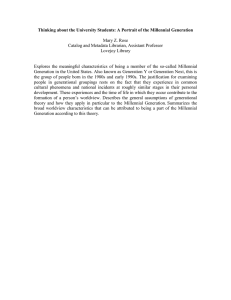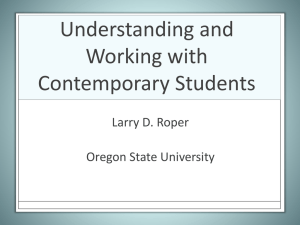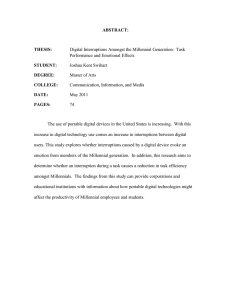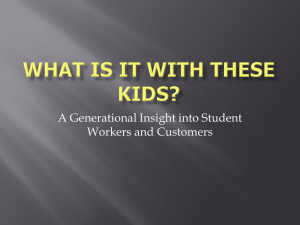Differences in motives between Millennial and Generation X medical
advertisement
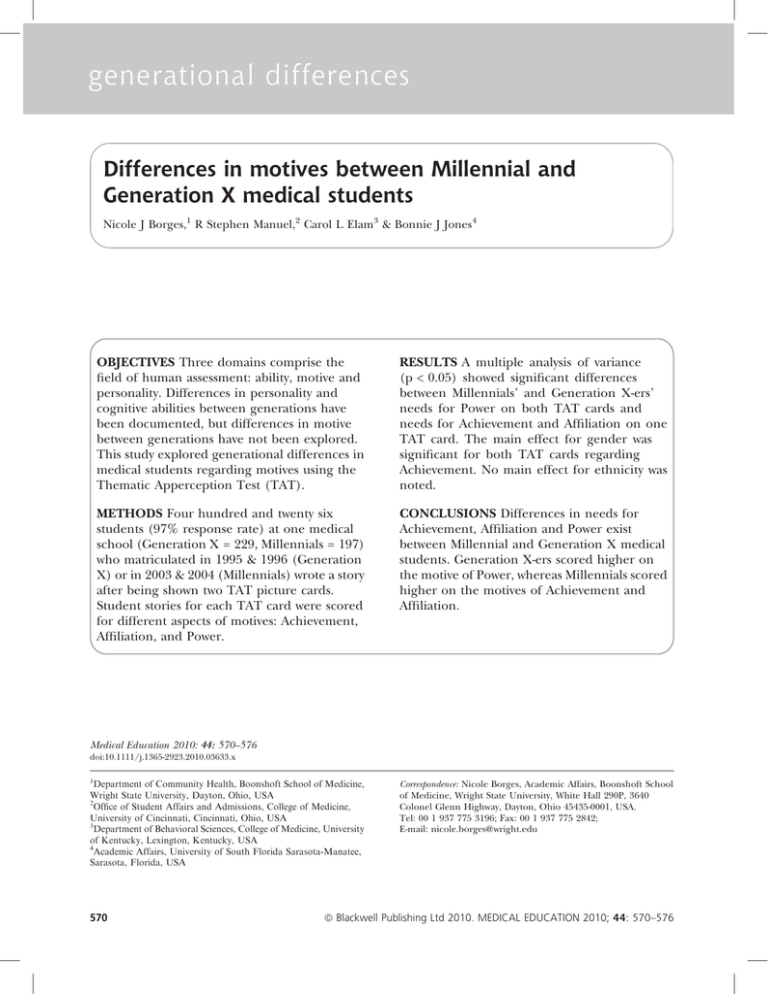
generational differences Differences in motives between Millennial and Generation X medical students Nicole J Borges,1 R Stephen Manuel,2 Carol L Elam3 & Bonnie J Jones4 OBJECTIVES Three domains comprise the field of human assessment: ability, motive and personality. Differences in personality and cognitive abilities between generations have been documented, but differences in motive between generations have not been explored. This study explored generational differences in medical students regarding motives using the Thematic Apperception Test (TAT). RESULTS A multiple analysis of variance (p < 0.05) showed significant differences between Millennials’ and Generation X-ers’ needs for Power on both TAT cards and needs for Achievement and Affiliation on one TAT card. The main effect for gender was significant for both TAT cards regarding Achievement. No main effect for ethnicity was noted. METHODS Four hundred and twenty six students (97% response rate) at one medical school (Generation X = 229, Millennials = 197) who matriculated in 1995 & 1996 (Generation X) or in 2003 & 2004 (Millennials) wrote a story after being shown two TAT picture cards. Student stories for each TAT card were scored for different aspects of motives: Achievement, Affiliation, and Power. CONCLUSIONS Differences in needs for Achievement, Affiliation and Power exist between Millennial and Generation X medical students. Generation X-ers scored higher on the motive of Power, whereas Millennials scored higher on the motives of Achievement and Affiliation. Medical Education 2010: 44: 570–576 doi:10.1111/j.1365-2923.2010.03633.x 1 Department of Community Health, Boonshoft School of Medicine, Wright State University, Dayton, Ohio, USA 2 Office of Student Affairs and Admissions, College of Medicine, University of Cincinnati, Cincinnati, Ohio, USA 3 Department of Behavioral Sciences, College of Medicine, University of Kentucky, Lexington, Kentucky, USA 4 Academic Affairs, University of South Florida Sarasota-Manatee, Sarasota, Florida, USA 570 Correspondence: Nicole Borges, Academic Affairs, Boonshoft School of Medicine, Wright State University, White Hall 290P, 3640 Colonel Glenn Highway, Dayton, Ohio 45435-0001, USA. Tel: 00 1 937 775 3196; Fax: 00 1 937 775 2842; E-mail: nicole.borges@wright.edu ª Blackwell Publishing Ltd 2010. MEDICAL EDUCATION 2010; 44: 570–576 Motives of Millennial and Generation X medical students INTRODUCTION For the last decade or so, attention to and dialogue about generational differences have grown in higher education. This increased focus on generations has probably been spurred by popular books written on generations in the early years of the 21st century.1,2 Howe and Strauss1 posit that people within specific generations share some defining characteristics because of the environmental events that shape their view of the world during their formative years.1 Defining a generational period as lasting roughly 20 years, Lancaster and Stillman2 contend that our recent and current student bodies are largely comprised of two cohorts, Generation X, born between 1965 and 1980, and Millennials, born between 1981 and 1999. Key among the popular conceptualisations that differentiate these two generations of students is the perception that Generation X students are ‘me-oriented’ self-starters who are independent, pragmatic and sceptical,2 whereas Millennial students are seen as structured rule followers, who are confident, pressured, achieving, team-oriented and respectful.1 In addition, Millennials are thought to be community-focused problem solvers who want to address and right problems in society.1 Although these perspectives by population theorists have contributed to and guided discussions about generations, to date the vast majority of literature on generational differences remains largely descriptive or anecdotal rather than being based on the findings of empirical research studies. As a result, much that is written about the qualities of current students is criticised as being conjecture that has evolved into generalisations and stereotyping.3 Recognising the need for more empirical evidence documenting generational characteristics, Twenge and colleagues4–7 have made important contributions to the literature by conducting several cross-temporal, meta-analytic studies examining longitudinal databases containing students’ responses to various psychological questionnaires across eras.5–7 This work has corroborated the suggestion that differences do exist across the generations on such personality factors as extraversion, self-esteem and narcissism5–7 and other factors such as ‘self-satisfaction, high expectations, confidence in future performance, and a desire for leisure’4 and current Millennial-aged students have scored higher on these dimensions than students of previous generations. Referencing the generational descriptions of the population theorists cited, in our earlier work we compared responses of Generation X students with those of Millennial students on the 16 Personality Factors (16PF) questionnaire.8 We found that Millennial students scored higher on several personality factors as we had predicted, including: Perfectionism; Rule Consciousness; Sensitivity; and Warmth. As predicted, Generation X students scored higher on Self-Reliance. However, some of our other hypotheses were not supported as we had thought the independent, sceptical and pragmatic Generation X-ers would score higher on the Dominance, Vigilance and Privateness factors. Instead, there was no difference in the scores on those factors between the two generations studied. In this current paper, we extend our earlier work on personality and generational differences8 to determine if differences between two recent generations of students occur in additional domains of human assessment.9 Ability, motive, and personality are three domains comprising the field of human assessment.9 Two of these three domains have been investigated for generational differences. Personality differences between decades of generations have been supported in our earlier work8 and in results of meta-analytic studies.5–7 As for the ability domain, research10 supports generational differences on intelligence tests: current younger generations perform higher on measures of cognitive ability. Motives, a ‘disposition which is quite stable over time’,11 described as a ‘recurrent concern for a particular goal state, based on natural incentive, that energises, orients, and selects behaviour’,12 is the remaining domain that has not been explored between the generations. To that end, we investigate the applicability of Murray’s theory of motivation13 and McClelland’s work,12 particularly concerning the motives of Achievement, Affiliation and Power, which, in our opinion, are relevant in a medical school population that must sustain focus on the long-term educational goals of becoming a doctor, developing doctor–patient relationships, and influencing or impacting the field of medicine, respectively. Motives McClelland’s work12 stems from the earlier work of Murray,13 who introduced a theoretical and systematic approach to measuring human motivation and who studied manifestations of motives using the Thematic Apperception Test (TAT),14 a projective method of personality assessment for use in the understanding of an individual’s current needs, ª Blackwell Publishing Ltd 2010. MEDICAL EDUCATION 2010; 44: 570–576 571 N J Borges et al motives, emotions and conflicts. According to the theory of motivation, motives comprise three areas or needs: need for Achievement; need for Affiliation, and need for Power.13 The need for Achievement is described as the motive to succeed by ‘doing things better, with surpassing standards of excellence’.12 The need for Affiliation is described as the motive to share with others and a desire for ‘establishing, maintaining, or restoring a positive affective relationship with another person(s)’.15 The need for Power is described as the motive to influence others and ‘the desire to have an impact on others’.16 Table 1 Demographics of Millennial and Generation X students and results of chi-squared tests GeneraMillennials tion X n % Demographics n % v2 p-value Gender Men Women 78 39.6 123 53.7 119 60.4 106 46.3 110 55.8 109 47.6 87 44.2 120 52.4 8.470 0.004* Ethnicity Although most individuals possess and exhibit a combination of these motives or needs, some people demonstrate a strong bias toward a particular motivational need and this preference will influence behaviour. Based upon the assertions of current population theorists, Twenge’s work and our research, and because of differences in generational habitual patterns of thought and emotional responses, we believe that Millennial students and Generation X students will differ in the domain of motives, as measured by their responses to the TAT. We hypothesise that: Millennials will score significantly higher than Generation X-ers on: 1 2 3 need for Achievement because of Millennials’ perfectionism and goal-oriented drive to achieve; need for Affiliation because of Millennials’ affinity with teams, sociability and strong peer bonds, and need for Power because of Millennials’ desire to work with others in teams and to solve problems. White Non-White 2.878 0.09 * Significant at p < 0.05 level Measure The TAT14 was used as an open-ended method of measuring students’ personal motives. The TAT is a projective assessment technique comprised of picture cards. Each TAT picture card depicts a unique situation with different people and events. Responses purport to indicate underlying needs, motives, drives and personality conflicts.14,17 The TAT has been shown to have adequate reliability,18 with inter-rater reliability ranging from 0.83–0.92, test–retest reliability estimates (45-day interval) of 0.64–0.83 and adequate internal consistency reliability.19 Strong evidence for the TAT’s construct validity has accumulated from 40 years of research.20 Procedures METHODS Sample Participants were 426 Year 1 students (97% response rate; Generation X = 229, Millennials = 197) enrolled in a 6-year BS ⁄ MD programme at one US medical school, who matriculated in 1995 or 1996 (Generation X) or in 2003 or 2004 (Millennials). The average age of all participants was 18 years. Table 1 shows the sample demographics. There were significantly more women than men in the Millennial compared with the Generation X group. No significant differences between the cohorts were noted for ethnicity or for entering class academic profiles. 572 As part of an institutional review board-approved study of student non-cognitive factors, data collection occurred early during the first semester after students had matriculated. Participation in this aspect of the study required 10 minutes of the students’ time. Students were shown two TAT picture cards and wrote a story after seeing each. Card 1 showed a boy with a violin: ‘A young boy is contemplating a violin which rests on a table in front of him.’14 Card 2 showed a young girl with books in a field: ‘Country scene: in the foreground is a young woman with books in her hand; in the background a man is working in the fields and an older woman is looking on.’14 ª Blackwell Publishing Ltd 2010. MEDICAL EDUCATION 2010; 44: 570–576 Motives of Millennial and Generation X medical students These particular cards were chosen because of their relation to the motives of Affiliation, Achievement and Power depicted in them. For Card 1, for example, an interpretation related to the motive of Achievement might be: ‘A little boy seems to be upset because he cannot play his musical instrument as well as he would like…’21 For this same card, an interpretation referring to the Power motive might be: ‘The boy is very depressed because his parents force him to learn the violin…’21 For Card 2, a response relating to the Achievement motive might be: ‘This is a story of a girl who had great ambitions. Her father was a farmer, her mother a housewife. Even though she was from this poor background, she had the determination to study and achieve something, even through her hard difficulties in life.’21 For this same card, a response referring to Affiliation might be: ‘Rosa … was walking home and she saw her husband working the crops… She enjoyed living on the farm because she was close to her family.’21 Students were given the following instructions: ‘You are asked to write stories about pictures which will be shown on the screen. Each picture will only be displayed for 10 seconds. You will have 4 minutes to write a story on each picture.’ Following standard administration procedures for the TAT, for each of the stories students were instructed to identify the persons in the picture, the events that had led up to the situation in the picture, what was happening, and what would happen in the future. Scoring A single professional, who was external to this study and specifically trained in using McClelland’s scoring system, scored the stories of each cohort (i.e. Generation X and Millennial students). Each story was scored for different aspects of motives related to the needs for Achievement, Affiliation and Power, respectively, using standard scoring procedures for the TAT.22–24 Using McClelland’s scoring system, each story was scored according to 10 ‘aspects’, which, for example, include the aspects of Positive Affect (associated with achieving the need), Negative Affect (associated with failure to achieve the need), Block Person (when achieving the need is blocked by something in the character) and Block World (when achieving the need is blocked by something in the world). These same 10 aspects were used to first score the story for need for Power and then for need for Affiliation. Need for Achievement was scored using these 10 aspects plus one additional aspect, Nurtur- ant Press, which refers to someone in the story helping with the motive. A score of 1 indicated the aspect was present in the story and a score of 0 indicated this aspect was absent. For example, when scoring for Block World for need for Achievement, the rater assigned a ‘1’ if something in the world blocked the need for Achievement. If not, the rater assigned a ‘0’. For Block Person, a ‘1’ rating meant the story told of the need for Achievement being blocked by something in the character. Numbers under each category of motive (Achievement, Affiliation and Power) were summed for a total score. The maximum total score for need for Power and need for Affiliation was 10. For need for Achievement, the maximum total score was 11. The total scores for Achievement, Affiliation and Power were compared between Millennials and Generation X-ers. RESULTS Multiple analysis of variance (MANOVA) (p < 0.05) showed significant differences between Millennial and Generation X students’ scores for Power on both TAT cards and for Affiliation and Achievement on one TAT card (Tables 2 and 3). Effect sizes ranged from smaller than typical to typical or medium.25 Although significant differences existed between the groups on all three motives, only two of the three hypotheses for this study were supported. Millennials scored higher on the needs for Affiliation and Achievement, but Generation X students scored higher on the need for Power. The main effect for gender was significant for both TAT cards regarding Achievement (Card 1: p = 0.001; Card 2: p = 0.047), but not for Power or Affiliation. No main effect for ethnicity (i.e. White versus non-White) was noted. Table 2 Results of MANOVA for Thematic Apperception Test Card 1 (boy with violin) GeneraMillennials tion X Motives Mean SD Mean SD Affiliation 0.88 Achievement 2.14 Power 0.63 1.81 0.52 2.93 1.08 1.56 1.52 F p-value d 1.34 5.23 0.023* 0.226 2.02 18.98 < 0.001* 0.421 1.81 28.05 < 0.001* 0.527 * Significant at p < 0.05 level SD = standard deviation; d = effect size (Cohen’s d) ª Blackwell Publishing Ltd 2010. MEDICAL EDUCATION 2010; 44: 570–576 573 N J Borges et al Table 3 Results of MANOVA for Thematic Apperception Test Card 2 (young woman in field) Motives Millennials Generation X Mean SD Mean SD Affiliation 1.05 Achievement 0.94 Power 0.35 1.86 1.00 1.81 1.31 0.816 0.58 F p-value d 1.66 0.084 0.772 0.028 2.01 3.72 0.055 0.193 1.09 5.94 0.015* 0.238 * Significant at p < 0.05 level SD = standard deviation; d = effect size (Cohen’s d) DISCUSSION This research provides empirical evidence that supports the assertions of population theorists that Millennial students differ from Generation X students in certain behaviours and preferences.1 Findings from this study suggest that differences in motives of Achievement, Affiliation and Power exist between Millennial and Generation X medical students. Millennial students scored higher than Generation X students on the needs for Achievement and Affiliation. Thus, our study findings may substantiate the contentions of population theorists that, compared with previous generations, Millennials have greater needs to belong to social groups and to share with others, stronger team instincts and tighter peer bonds, and greater needs to achieve and succeed.2 These findings have implications for educators. Faculty members may motivate their Millennial students to learn by using group activities where they can apply course content and learn by doing, providing students with relationship-building opportunities in the classroom or online that contribute to collaboration and teamwork. Achievement-oriented Millennial students will also expect that faculty clearly specify educational goals and desired learning outcomes in the basic science and clinical curricula, and may express a strong need for feedback to monitor their progress and accomplishment. Our hypothesis that Millennial students would have a greater need for Power was not supported in this study, suggesting that Millennials may have less need to influence others and ensure that their ideas prevail compared with Generation X students. Instead, the team-oriented Millennials are probably drawn to 574 efforts that contribute to collaboration and consensus. In our attempt to make sense of why our hypothesis was not supported, we revisited some of the differences between Millennials and Generation X-ers posited by population theorists. Our review led us to entertain the idea that perhaps Generation X-ers scored higher on the need for Power because some of their personal characteristics (i.e. resourcefulness and independence) contribute to their self-sufficiency and self-assertion, which can be considered hallmark behaviours associated with individual power.1,26 Given this, we recognise that possibly we were mistaken when formulating our hypothesis about Power. Regardless, generational differences in Power may have implications for educators who are preparing the next generation of doctors. Although Howe and Strauss1 argue that Millennial students are confident as a group, it is not clear whether the individual Millennial student feels personally empowered.26 If Millennials are less motivated to influence others, faculty members may need to pay attention to adding more classroom activities and online experiences that allow their students to engage in leadership skills development. In fact, at the University of Kentucky medical students have recently designed and implemented a programme entitled Leadership Legacy, in which they explore, learn and apply the leadership skills necessary for doctors. Similarly, at Wright State University Boonshoft School of Medicine, the Boonshoft Physician Leadership Development Programme prepares future doctors for leadership roles in order to shape the health care of the future. An alternative rationale, however, as to why Generation X students scored higher on need for Power than Millennial students could be traced back to McClelland’s definition of this attribute as a motivation toward increasing personal status and prestige. Perhaps Millennial students, who are entering medicine at a time of record high tuition fees and medical education debt, and whose future is overshadowed by the spectre of cost controls in the health care setting which may reduce potential earnings, are indeed less motivated by financial reward than their Generation X counterparts were. Millennial students may be more concerned with their personal achievement than with the remunerative rewards of success. Although the results of this study show support for differences in motives between Millennial and Generation X students, several limitations exist that should be considered when interpreting the findings. ª Blackwell Publishing Ltd 2010. MEDICAL EDUCATION 2010; 44: 570–576 Motives of Millennial and Generation X medical students Firstly, the TAT is a projective measure of assessment and projective measures are more highly criticised than objective measures of assessment.27 That said, the long-standing and ongoing discussion28 about objective versus projective measures is likely to continue for decades to come. Secondly, as for our methods, we acknowledge that our study would have been more rigorous had we had more than one person independently score each TAT story. Thirdly, in the cases in which smaller than typical effect sizes were noted, the data should be interpreted with this in mind. On Card 1 of the TAT, although the motive of Affiliation was significantly different for Millennials and Generation X-ers, the effect size was small. On Card 2 of the TAT, the effect size was small for the motive of Power. Fourthly, the significant finding of a main effect for gender for the Achievement motive suggests that gender may be a factor in the significant difference between generations on this motive. Finally, the sample for this study consisted of BS ⁄ MD students from one US medical school and therefore generalising the findings of this study to other populations may be limited. There remains a void in the literature regarding empirical studies to support or refute differences between current generations of medical students. Our current paper contributes to the literature and expands the empirical research on generational differences. In this paper, we extend our earlier work on personality and generational differences by showing that there are measurable differences between Millennials and Generation X-ers regarding the additional domains of human assessment (i.e. motives). Further research to differentiate Millennials and Generation X-ers on the domain of motive – as well as other factors – is encouraged. The challenge will be to find suitable assessment tools that are applicable and able to measure the characteristics of these two generations. Contributors: all authors contributed to the conception and design of the overall study. NJB, RSM and BJJ collected the data. NJB analysed the data and wrote the first draft of the manuscript. All authors contributed to data interpretation and the revision of the paper. CLE contributed important content regarding generations. All authors approved the final manuscript. Acknowledgements: none. Funding: none. Conflicts of interest: none. Ethical approval: this study was approved by the Northeastern Ohio Universities College of Medicine, Rootstown, Ohio, USA. REFERENCES 1 Howe N, Strauss W. Millennials Rising: The Next Great Generation. New York, NY: Vintage Books 2000. 2 Lancaster LC, Stillman D. When Generations Collide: Who They Are, Why They Clash, How to Solve the Generational Puzzle at Work. New York, NY: Harper Business 2003. 3 Hoover E. The millennial muddle: how stereotyping students became a thriving industry and a bundle of contradictions. Chron High Educ 2009; LVI:A1, A28–A34. 4 Twenge JM. Generational changes and their impact in the classroom: teaching Generation Me. Med Educ 2009;43:398–405. 5 Twenge JM. Birth cohort changes in extraversion: a cross-temporal meta-analysis, 1966–1993. Pers Individ Dif 2001;30:735–48. 6 Twenge JM, Campbell WK. Age and birth cohort differences in self-esteem: a cross-temporal meta-analysis. Pers Soc Psychol Rev 2001;5:321–44. 7 Twenge JM, Konrath S, Foster JD, Campbell WK, Bushman BJ. Egos inflating over time: a cross-temporal meta-analysis of the Narcissistic Personality Inventory. J Pers 2008;76:875–901. 8 Borges NJ, Manuel RS, Elam CL, Jones BJ. Comparing Millennial and Generation X medical students at one medical school. Acad Med 2006;81:571–576. 9 Schuerger JM. The sixteen personality factor questionnaire and its junior versions. J Couns Dev 1992;71:231–44. 10 Flynn JR, Weiss LG. American IQ gains from 1932 to 2002: the WISC subtests and educational progress. Int J Testing 2007;7:209–24. 11 Winkel S, Petermann F. Assessment in Achievement motivation. In: Zelick P, ed. Issues in the Psychology of Motivation. New York, NY: Nova Science Publishers 2007;23–40. 12 McClelland DC. Human Motivation. Glenview, IL: Scott Foresman 1985. 13 Murray HA. Explorations in Personality. New York, NY: Oxford University Press 1938. 14 Murray HA. Thematic Apperception Test Manual. Cambridge, MA: Harvard University Press 1943 (Reprinted 1971). 15 Atkinson JW, Heyns RW, Veroff J. The effect of experimental arousal of the affiliation motive on thematic apperception. J Abnorm Soc Psychol 1954;49:405–10. 16 Winter DG. Power motivation revisited. In: Smith CP, ed. Motivation and Personality: Handbook of Thematic Content Analysis. Cambridge; New York, NY: Cambridge University Press 1992;301–10. 17 Morgan C, Murray H. A method for investigating fantasies: the Thematic Apperception Test. Arch Neurol Psychiatry 1935;34:289–306. 18 Lundy A. The reliability of the Thematic Apperception Test. J Pers Assess 1985;49:141–9. 19 Ronan GF, Gibbs MS, Dreer LE, Lombardo JA. Personal problem-solving system – revised. In: Jenkins ª Blackwell Publishing Ltd 2010. MEDICAL EDUCATION 2010; 44: 570–576 575 N J Borges et al 20 21 22 23 576 SR, ed. Handbook of Clinical Scoring Systems for Thematic Apperception Techniques. New York, NY: Lawrence Erlbaum Associates 2008;181–207. Woike BA, McAdams DP. TAT-based personality measures have considerable validity. Observer 2001;14:10. Thomas AD. TAT Affective Scale Manual. In: Jenkins SR, ed. Handbook of Clinical Scoring Systems for Thematic Apperception Techniques. New York, NY: Lawrence Erlbaum Associates 2008;489–546. McClelland DC, Atkinson JW, Clark RA, Lowell EL. A scoring manual for the achievement motive. In: Atkinson JW, ed. Motives in Fantasy, Action and Society. New York, NY: Van Nostrand 1958;179–204. Heyns RW, Veroff J, Atkinson JW. A scoring manual for the affiliation motive. In: Atkinson JW, ed. Motives in Fantasy, Action and Society. New York, NY: Van Nostrand 1958;205–18. 24 Veroff J. A scoring manual for the power motive. In: Atkinson JW, ed. Motives in Fantasy, Action and Society. New York, NY: Van Nostrand 1958;219–33. 25 Cohen J. Statistical Power Analysis for the Behavioral Sciences, 2nd edn. Hillsdale, NJ: Lawrence Erlbaum Associates 1988. 26 Diekman AB, Goodfriend W, Goodwin S. Dynamic stereotypes of power: perceived change and stability in gender hierarchies. Sex Roles 2004;50:201–5. 27 Lilienfield SO, Wood JM, Garb HN. What’s wrong with this picture? Sci Am 2001;284:80–7. 28 Cramer P. Questions of reliability and validity. In: Storytelling, Narrative, and the Thematic Apperception Test. New York, NY: Guilford Press 1996;250–69. Received 18 August 2009; editorial comments to authors 16 September 2009, 1 December 2009; accepted for publication 24 December 2009 ª Blackwell Publishing Ltd 2010. MEDICAL EDUCATION 2010; 44: 570–576
